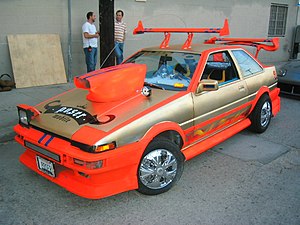The examples and perspective in this article may not represent a worldwide view of the subject.(December 2019) |


Boy racer is a term given to a young person who drives in a fast and aggressive manner; it has become a broader term (often pejorative) for participants in modern custom car culture who tune and modify cars with street racing-style aftermarket cosmetic and performance parts such as body kits, audio systems and exhausts. The culture encompasses a broad range of car types including sport compacts and economy cars typical of the import scene, this is in contrast with the hot rod culture of previous generations. [2] Some car enthusiasts and modifiers feel the term labels them as deviant and anti-social and are keen to distance themselves from the term. [3] Boy racer is a term mostly but not exclusively associated with the UK, in Australia and New Zealand hoon is sometimes preferred. In the US, "Rice boy" or "Ricer" is a derogatory term for the driver or builder of an imported hot rod, or someone who modifies their car in a cheap way to imitate the look of a higher performance vehicle.
Contents
Responses to the boy racer phenomenon range from laws prohibiting certain cosmetic modifications to vehicles such as decorative lighting or tinted windows to restrictions on cruising.
